Muscle Building Exercises Easy on the Neck
Given that we specialize in helping skinny guys bulk up, we often get asked how to build a thicker neck. And I can relate to that. I always hated how skinny my neck was. When I first started bulking, my neck circumference 14 inches—a long way from the average man's 16-inch neck. And even after gaining a full 60 pounds, my neck had only gone up to 14.5 inches. Clearly, building muscle overall wasn't doing anything for my skinny neck.
That's where neck training comes in. Doing muscle-building exercises to bulk up the muscles in our necks is a fairly new thing. It's not common in either bodybuilding or strength training. But neck training has a long history in contact sports and martial arts, given that it reduces the risk of concussions, knockouts, and brain trauma. We can look at that research and then modify it for our own goal of building thicker, stronger, and better-looking necks. And, as a bonus, our necks will grow tougher, too.
Given the paucity of research, I was skeptical about how well a neck bulking routine would work. But within a few months of doing neck training while resting between sets, I was able to add over an inch to my neck circumference. We were then able to reproduce those results with members of our community.
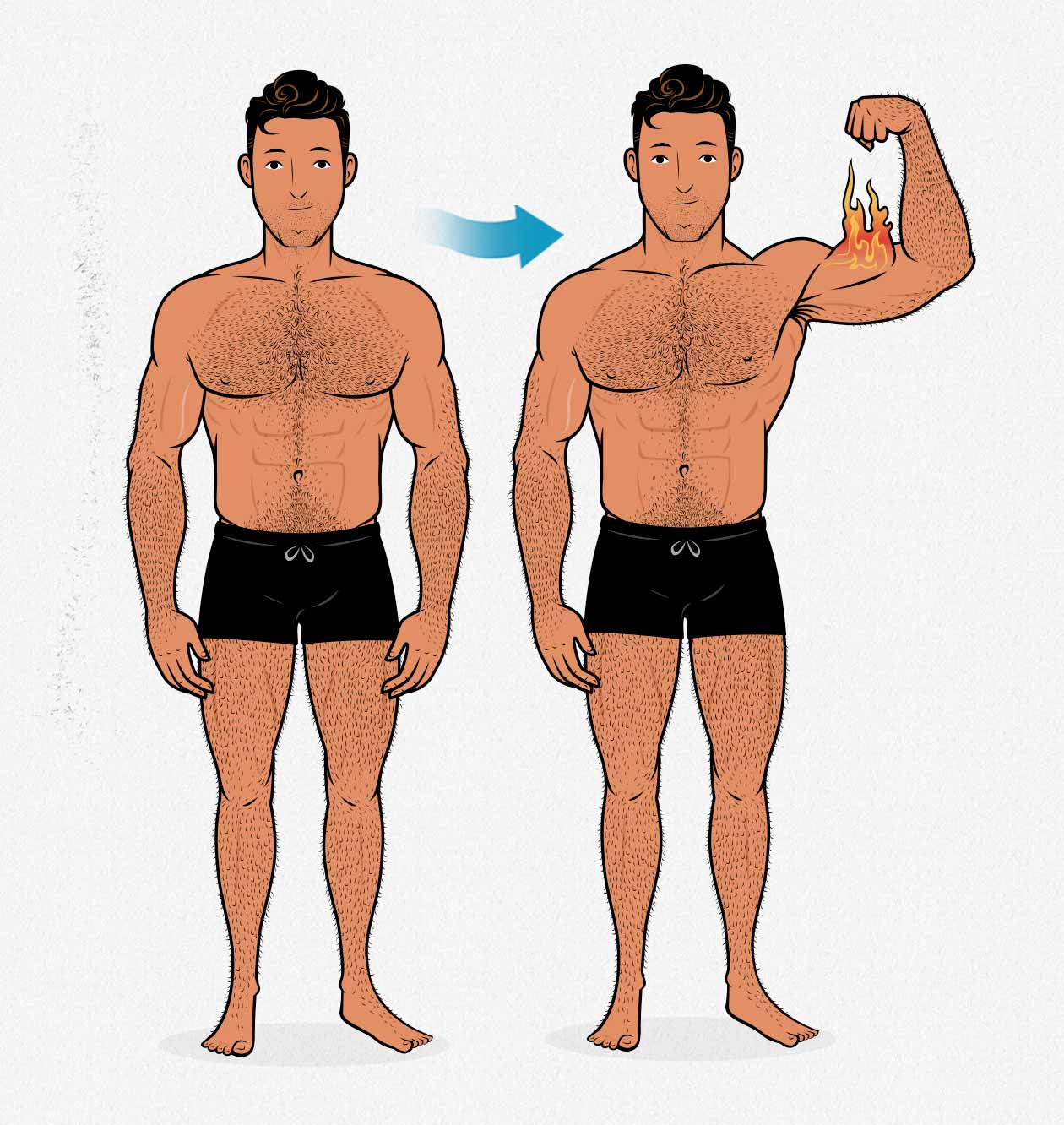
Introduction
If you're a fan of Bony to Beastly, you'll know that we're all about the bulking transformations. Marco and I have each gained sixty pounds at under 11% body fat, and over the past eight years, we've helped nearly 10,000 skinny guys bulk up (transformations here). Most of our articles are built around a mix of research, personally having done it ourselves, and our experience helping others.
So before we talk about building a thicker neck, I figure I should start by showing you my own results. As you can see, I gained 55 pounds during my first two years of serious bulking, and I managed to add completely overcome my naturally skinny neck:
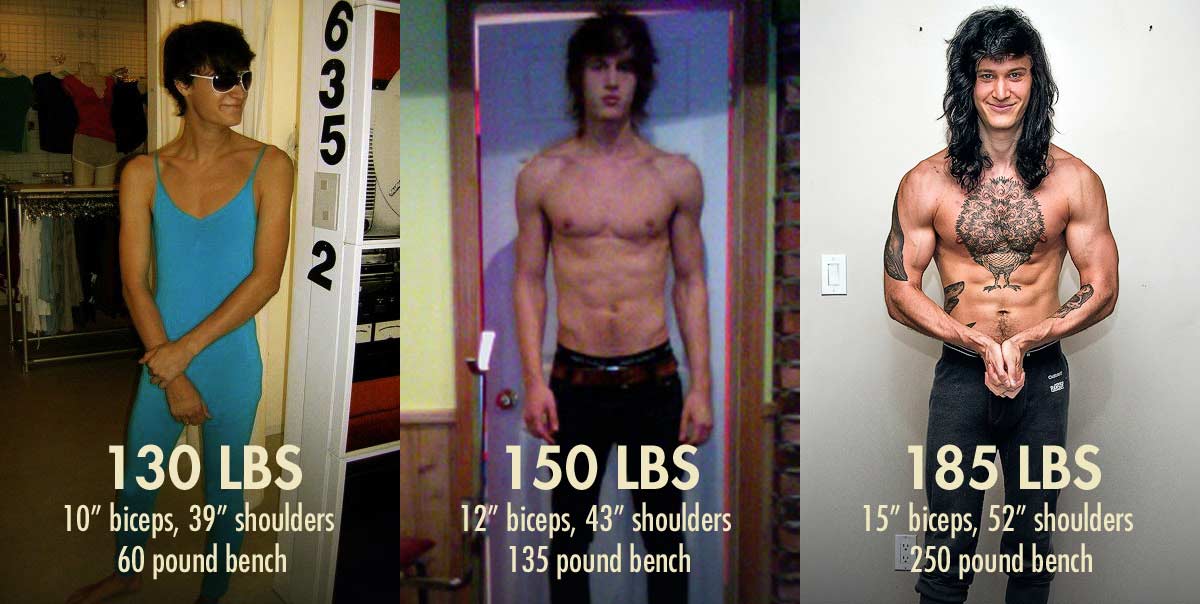
More seriously, over the course of gaining those 55 pounds, I gained around half an inch on my neck. My neck went from 14″ to 14.5″. To put that into perspective, I gained thirteen inches on my shoulders (39 to 52″) and five inches around my biceps (10 to 15″), whereas my neck grew by less than an inch. In fact, because my shoulders had grown so much broader, my neck looked actually looked proportionally skinnier by the end of my bulk.
The odd thing was, in photos where you could see my whole body, I looked pleasantly muscular, but then in photos of just my head, I looked as skinny as ever. Until I started training my neck:

These before and after photos were taken three months apart and show my neck circumference going from 14.5 inches up to 16 inches. I have candid photos showing the change, too. Here are some progress photos of me holding my son, taken just a few months apart:

In retrospect, the reason that my neck lagged is obvious. I never trained it. It's like never training your chest and then wondering why your chest isn't growing. But neither bodybuilders nor powerlifters train their necks, so I had assumed it must be dangerous or unnecessary. Little did I realize that neck training was ubiquitous in martial arts and contact sports. Had I known, I could have been doing neck training right from the very beginning.
My goal was to bring up my neck circumference to match my arm circumference: fifteen inches. Within a couple of months, my neck had grown to sixteen inches, outgrowing my arms. The funny thing is, neck training has had a more positive impact on my appearance than arm training ever did.
Should We Build Muscle in Our Necks?
Are Neck Workouts Safe?
The short answer is that, yes, when neck training is done correctly, it's quite safe. For example, if we're doing neck curls with a 25-pound plate, the load is being supported by our muscles, our hands are there to catch the weight if our neck muscles get tired, and 25 pounds is a fairly light load on our spines anyway. It's not likely to result in injury, and if it does, it's likely to be a minor muscle strain that heals on its own within a couple of weeks.
The long answer is that although neck training is safe overall, some ways of training our necks are less risky than others. Since training our necks usually involves flexing and extending our cervical spines, it can seem analogous to flexing and extending our lumbar spines when deadlifting. What we're forgetting, though, is that neck training is much, much lighter than deadlifts. It's more analogous to flexing and extending our lumbar spines when doing crunches, which most research shows is completely safe, even when doing for hundreds of repetitions every day for an entire lifetime.
But just to be totally sure, I confirmed that neck training was safe with both Greg Nuckols, MA, who runs the top research review, Monthly Applications in Strength Sport, and with my business partner, Marco Walker-NG, BHSc, PTS, who's trained professional and Olympic football and rugby players.
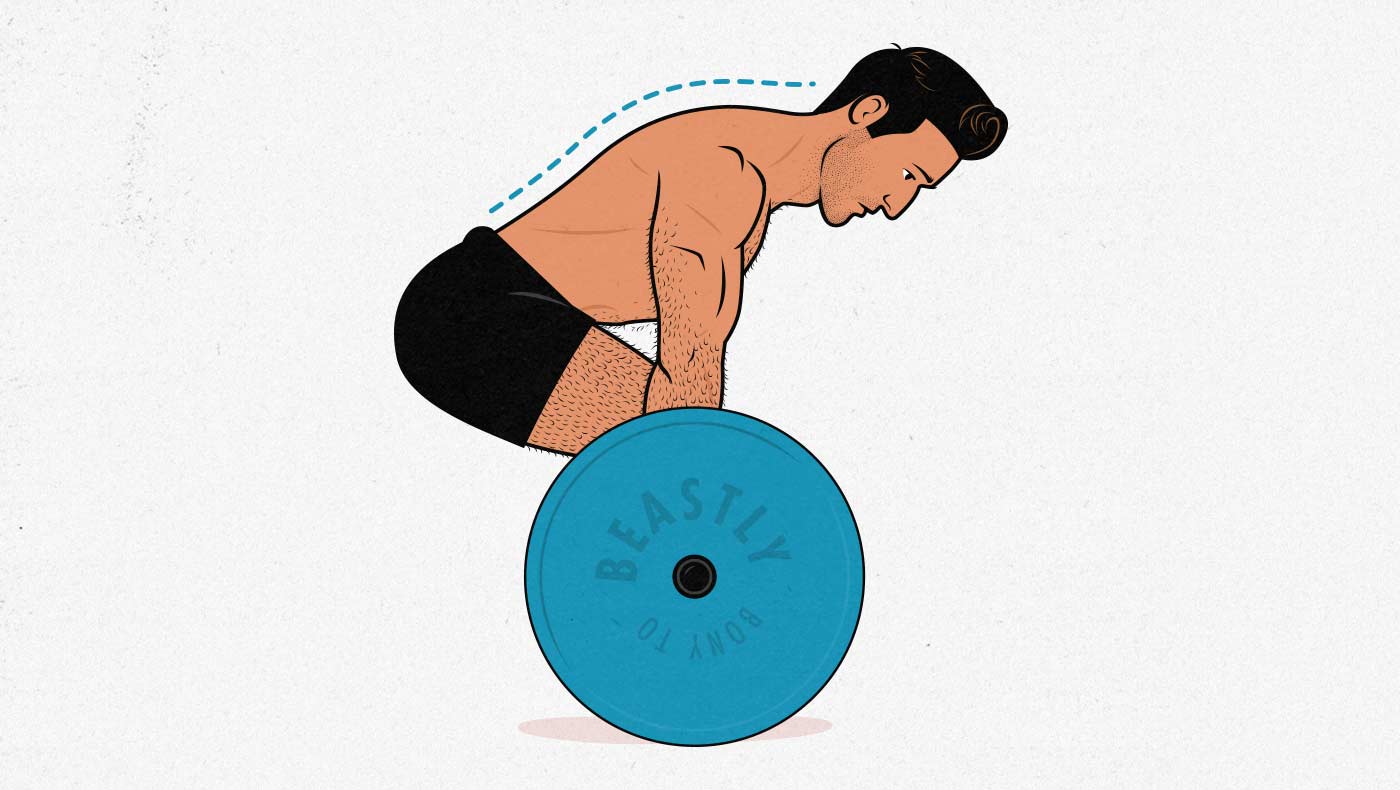
However, there's one extra thing to consider when flexing and extending our spines. Most of our joints, such as our knees, elbows, hips, and shoulders, are designed to move through a large range of motion. Our spine is made up of many different joints, and each is designed to move through only a small range of motion. As a result, if we wanted to play it safe, we might stop our range of motion a bit short, especially when lowering the weight. That may not be needed, but it's a more cautious way of training our necks.
It's also possible to train our necks the same way that we train our spinal erectors: with isometrics. When we squat and deadlift, we aren't flexing and extending our spines; we're just holding them steady under load. And over time, that yields quite a lot of growth in our spinal erectors and traps. The same can be done with our necks. Instead of lifting and lowering the weight, we could hold it in place, letting our muscles fight to maintain proper neck posture. That's not the most efficient way to bulk up our neck muscles, but it will work. I suspect that's over-cautious, though, given that athletes routinely train their necks with a large range of motion and don't run into problems beyond the occasional pulled muscle or "zinger" (which we'll cover below).
Plus, having a stronger neck can help us avoid injuries. Even if we don't do martial arts or play contact sports, having stronger necks can help us avoid injury if we ever get into a fight or car accident. This is especially important for those of us with skinny necks, given that there's less muscle there to buffer the impact.
Neck Size & Sleep Apnea
Seventeen inches. According to a study published in the European Respiratory Journal, that's how thick you can build your neck before it starts to increase your risk of sleep apnea. A second study then confirmed this finding. But it's not quite that simple. Most people have oversized necks because they're overweight, not because they have muscular necks.

Dr Brandon Peters, MD, a sleep medicine specialist, wrote that sleep apnea might be caused by fat in and around the neck, not simply having a thicker neck.
First, as an individual becomes more overweight or obese, one area of the body that becomes larger in circumference is the neck. Therefore, a large neck likely corresponds to increased fat tissue elsewhere in the body, including at the base of the tongue and lining the airway. Aside from having a large stomach, there will also be tissue crowding along the airway, especially in the throat.
–Dr Brandon Peters, MD
We get the same hypothesis from the Mayo Clinic:
In most people, a neck size greater than 16 or 17 inches is a sign of excess fat in the neck area. This may contribute to crowding and narrowing of your breathing tube, making obstruction or blockage of your airway while you sleep all the more likely.
–The Mayo Clinic
There seems to be a consensus that sleep apnea is linked to neck fat, not neck muscle. However, it might still be prudent not to push it. There isn't much research looking into what happens if we build our necks much bigger than 17–18″ inches, and given how important sleep is, I'm not eager to become a guinea pig.
Regardless, for someone like me, starting off with a fourteen-inch neck and bulking it up to sixteen inches, that's simply not a concern. I'm not even flirting with that threshold.
Neck Aesthetics
What's the Average Neck Size?
According to a study published in the Journal of Diabetes Research, the mean neck circumference for a man is 16.5 inches. Other articles and studies have different findings, with some finding that the average male neck size is closer to 15 inches. So although we can't say for sure, it seems like most men have necks somewhere between 15 and 16.5 inches.
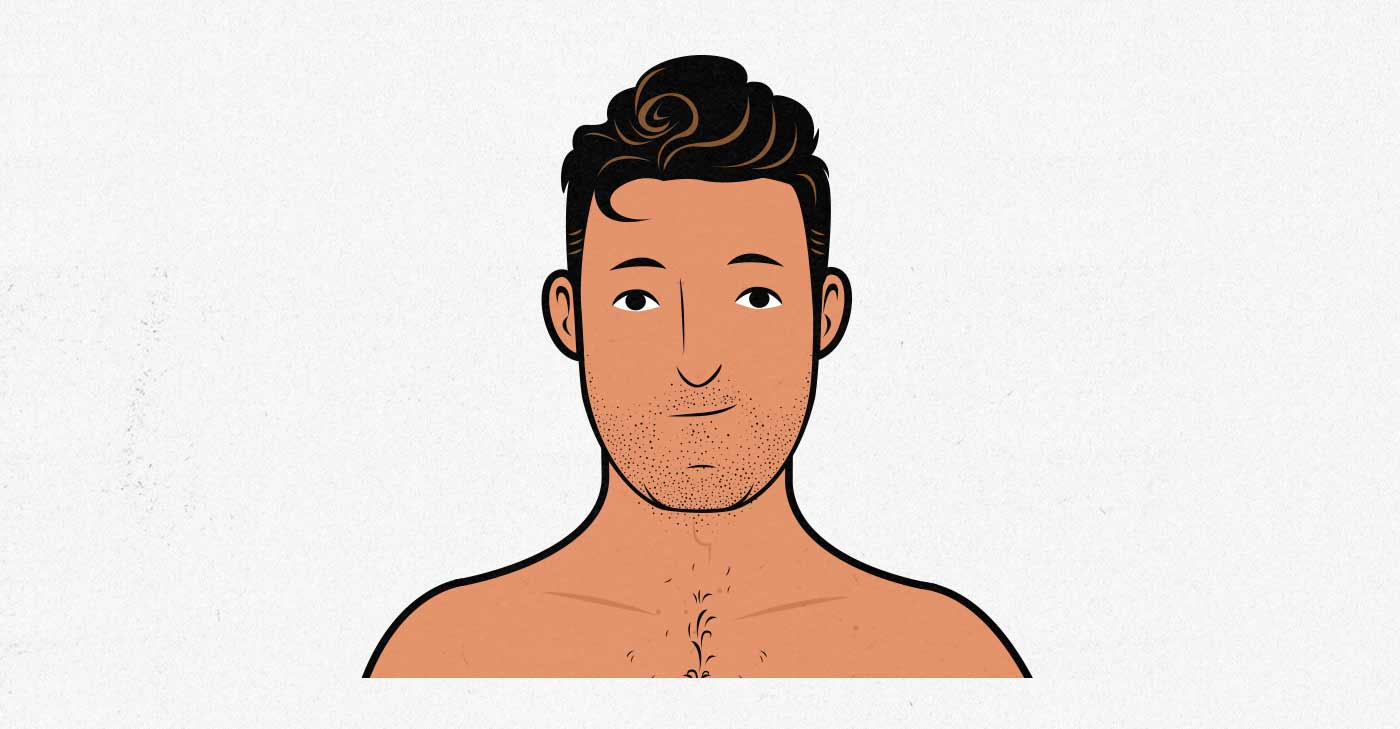
When I first saw that, I thought of my own fourteen-inch neck and felt disheartened. I had gained sixty pounds, and my neck was still 1–2 inches smaller than average. However, keep in mind that the average man has a large neck because he's overweight, not because his neck is strong and muscular. If we build muscular traps and have muscular necks even at lower body-fat percentages, I think our necks can look quite strong, even at smaller sizes.
Still, I think it's interesting that our necks will look smaller-than-average up until around fifteen inches and won't start to look remarkably big up until around seventeen inches. It certainly explains why my fourteen-inch neck looked so skinny. It also explains why I started being happy with how my neck started looking once it started getting up to around sixteen inches.
What's the Ideal Neck Size?
Dr Casey Butt, PhD, famous for studying genetic muscular potential and ideal body proportions, wrote in Your Muscular Potential that the ideal neck size is the same as the ideal biceps size. He then lists the most attractive biceps circumference as being 0.36 the size of our chests.
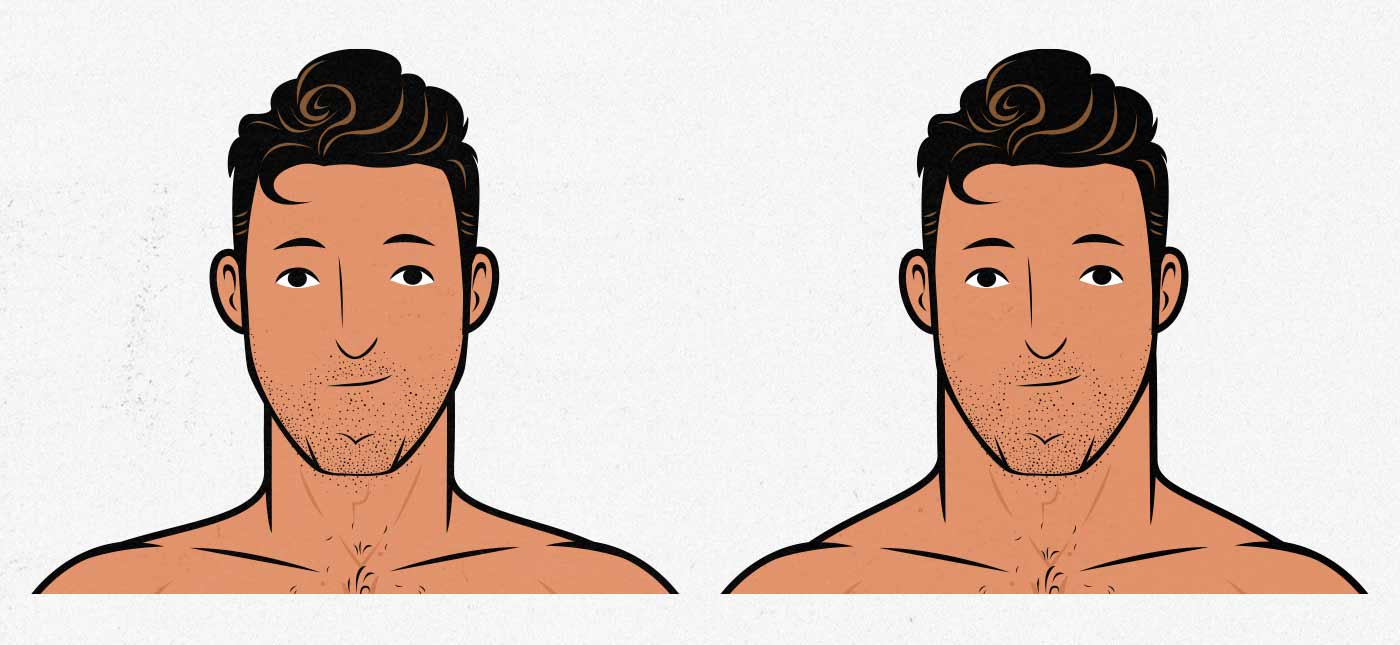
However, I then spoke with Dr Aaron Sell, a prominent attractiveness researcher, who told me that the link between neck size and attractiveness hasn't been studied in isolation from overall muscularity and strength. His research shows that the stronger and more formidable we appear (especially in our upper bodies), the more attractive we look to women. Neck size is certainly a predictor of formidability—as evidenced by how essential neck strength is when fighting—so I'd expect it to be strongly linked with attractiveness. But since neck size hasn't been studied in isolation from overall muscularity, we can't really be sure, let alone put a specific number to it.
It seems fairly logical, though, that having a muscular-but-not-apnea-inducing neck would look best, and I suspect that Casey Butt's ratios are pretty close to hitting that mark. According to his research, we get ratios that look something like this:
- Ideal waist size: our waist size at 8–15% body fat.
- Ideal biceps size: waist × 0.50
- Ideal neck size: waist × 0.50
For example, my waist is 31 inches, giving me an ideal biceps and neck size of 15.5 inches. Fortunately, that puts my ideal neck size well below what would put me at higher risk for developing sleep apnea. It also lines up with the results of our attractiveness survey.
These are loose ratios, though. Our necks can vary in length, as can the size of our traps, as can our shoulders' width. It might be that your neck looks best at a size that's a little different from those recommendations. Still, it's the best rule of thumb that we have.
The good news about the ideal neck size being so reasonable is that although it took me over two years to go from ten to fifteen-inch biceps, it only took a few months to bring my fourteen-inch neck up to sixteen inches. Building an aesthetic neck is far easier than bulking up the rest of our bodies.
How to Build A Thicker Neck
Neck Muscle Anatomy
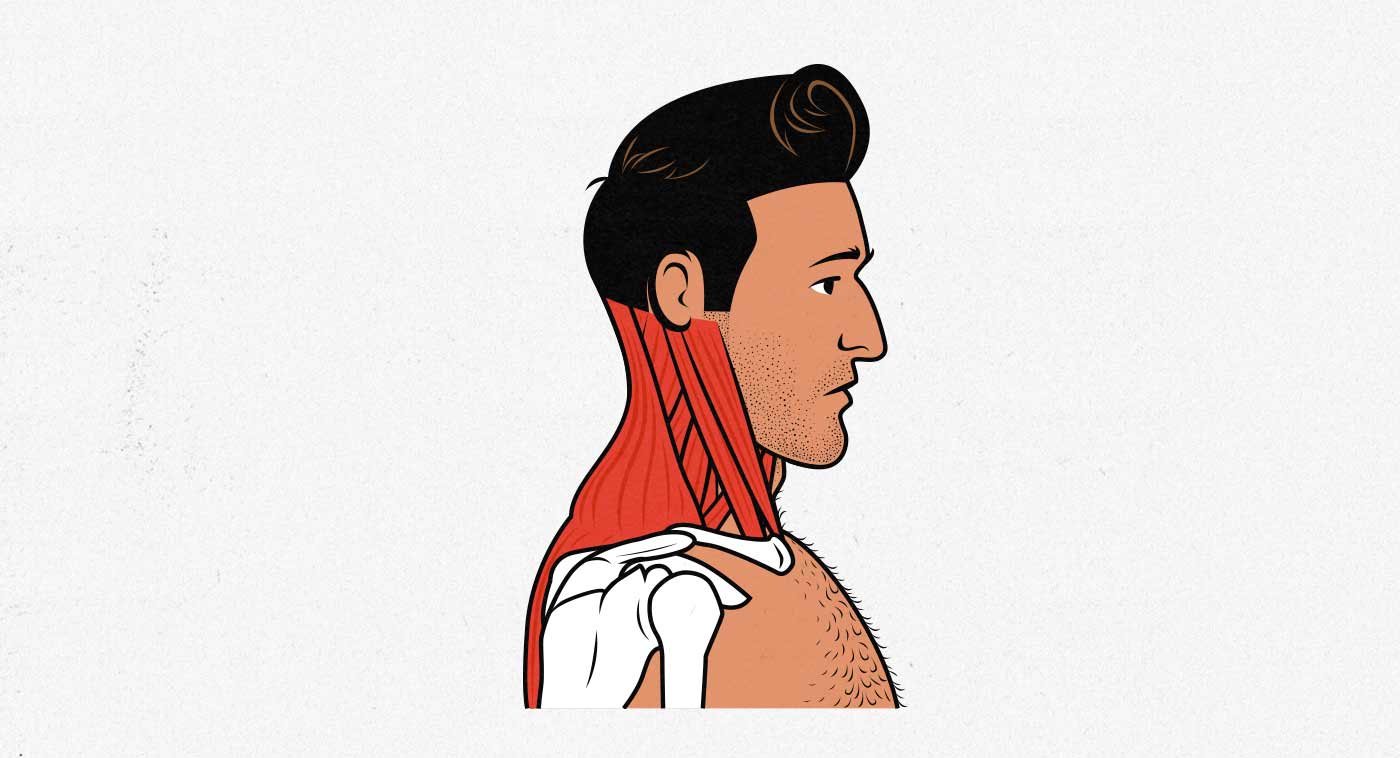
Our necks are riddled with muscles that help us flex, extend, twist, and turn our necks. When we train our necks, we'll gain size and strength throughout our necks, but most of our results will come from bulking up just two muscles: our upper trapezius and the sternocleidomastoid.
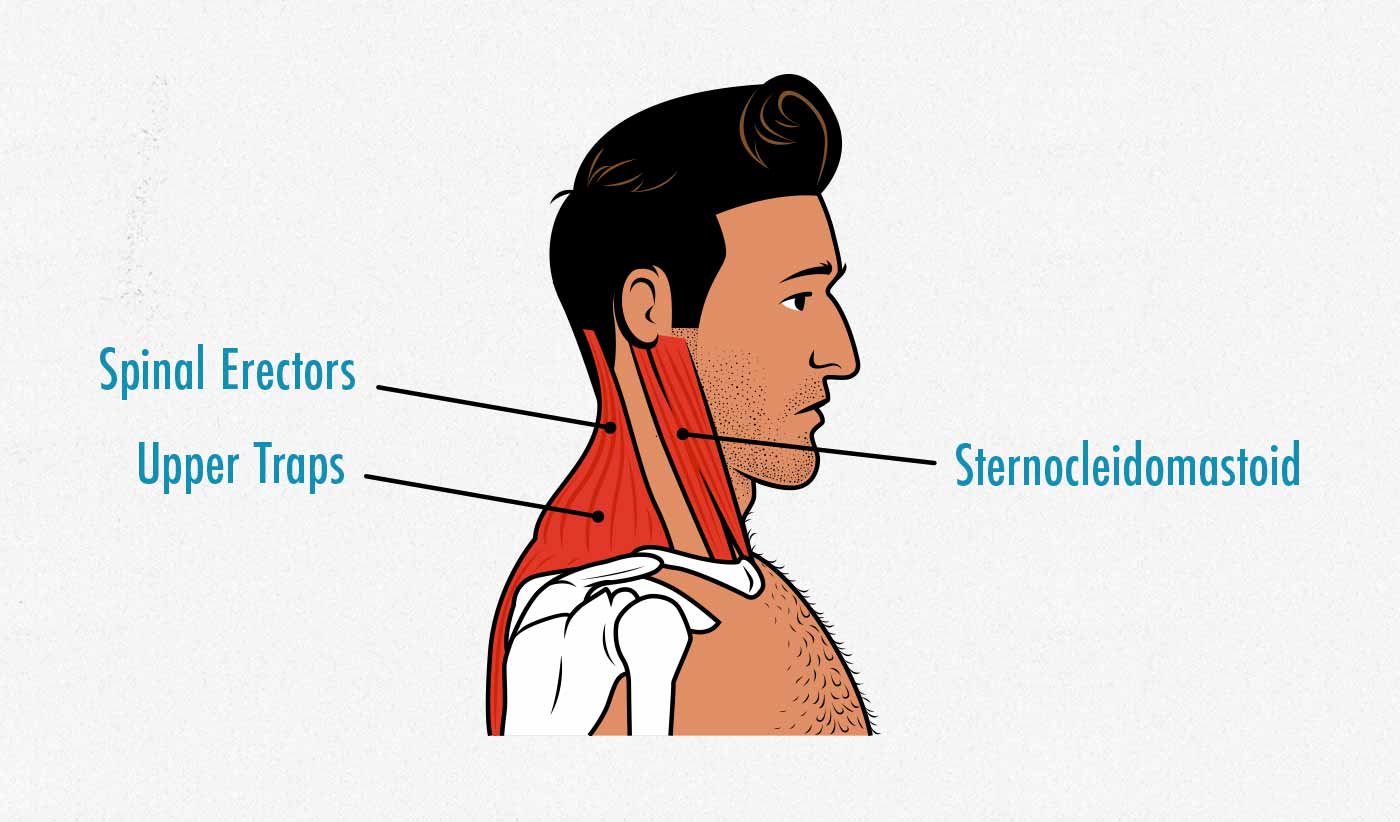
Our upper traps are by far the biggest muscle that affects the appearance of our necks. The good news is that because they help us shrug our shoulders, they're trained quite thoroughly with deadlifts, loaded carries, overhead presses, and even lateral raises. We don't need any dedicated lifts for our upper traps; we just need to build muscle overall.
Our spinal erectors are a different story. Spinal erectors are notoriously short, spanning just a couple of vertebrae. These particular spinal erectors attach so high up on our necks that they're only trained by lifts that have us driving our heads backwards, such as neck bridges and neck extensions. Growing these spinal erectors will toughen our necks and make our necks look more muscular when viewed from the side. But they won't actually make our necks look "thicker." For that, let's turn to the front view:
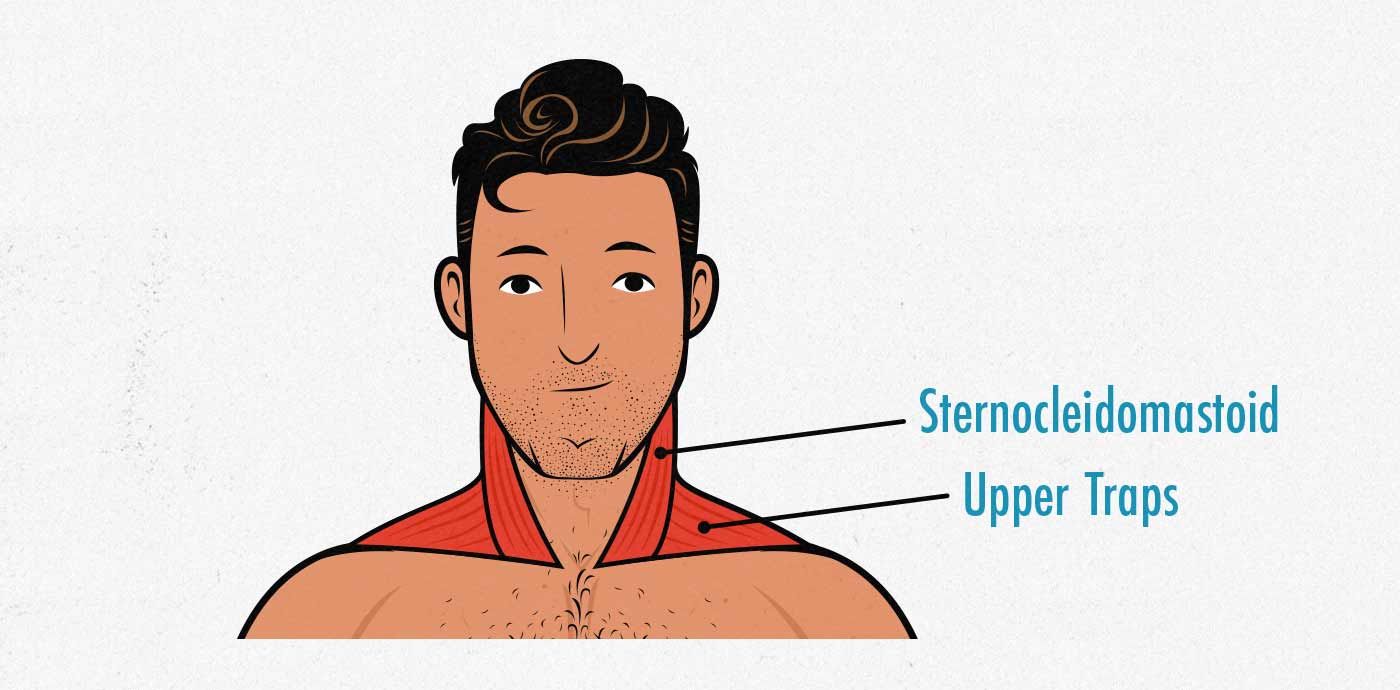
If we look at our neck muscles from the front, we see that our spinal erectors aren't visible. The muscles that influence the thickness of our necks are our upper traps (which are trained by compound lifts) and our sternocleidomastoid muscles.
Our sternocleidomastoid muscles are neck "flexors," meaning that they're trained by lifts that have us driving our heads forward, such as neck curls. What's neat about those sternocleidomastoid muscles, though, is that they also help us tuck our necks, giving us better neck posture. Now, to be clear, poor neck posture doesn't usually originate in the neck. It usually stems from poor rib and hip posture. But even so, strengthening these muscles may help improve so-called "forward head" posture, like so:
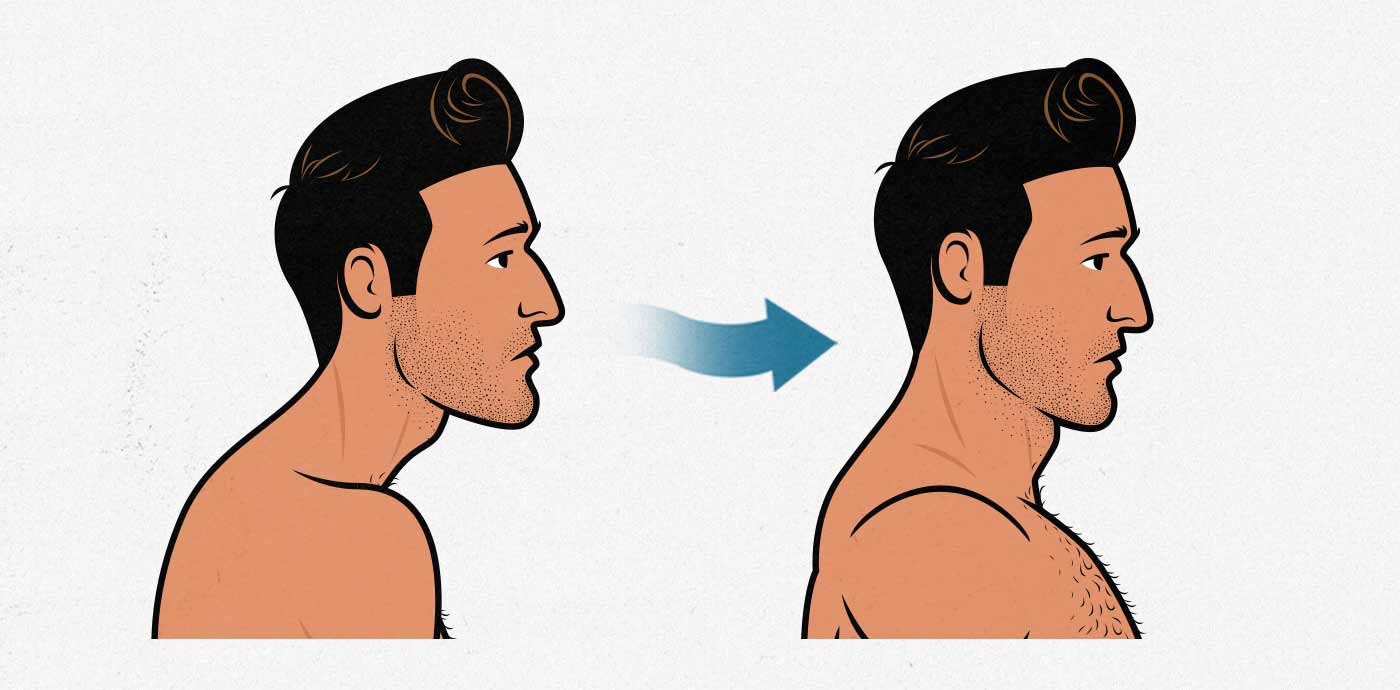
Finally, our neck muscles can bend and twist our necks from side to side, and so doing side raises with our necks can certainly help to bulk them up. However, those same muscles are trained with just neck curls, so we don't have to do any side raises to build a thick neck.
Overall, a good neck bulking routine is going to include some heavy compound lifts to train our big meaty upper traps, some extra neck extensions to make sure that we hit even the very uppermost fibres, and then plenty of neck curling to bulk up the sternocleidomastoid.
The Three Main Neck Lifts
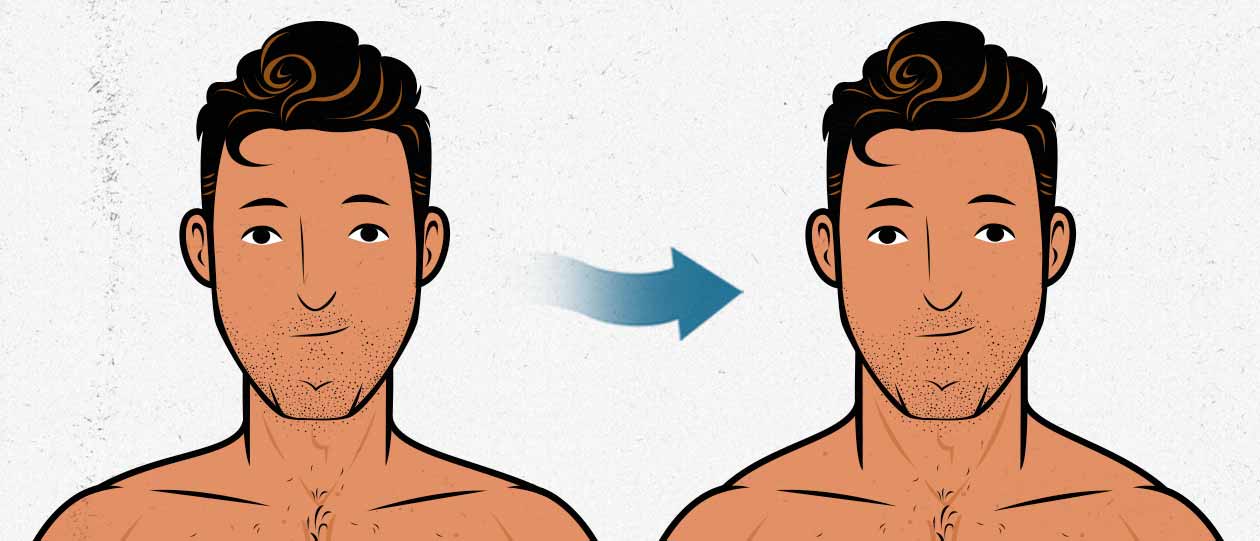
As we've covered above, the biggest "neck" muscles are our upper traps, which can be built with deadlifts, the overhead press, lateral raises loaded, carries, and, if you need even more than that, shrugs. However, our upper traps won't make our necks thicker, per se. For that, we need dedicated neck training.
The Neck Curl
The heart of any neck bulking routine is the neck curl. It trains the beefy sternocleidomastoid muscles that give us a thicker neck when viewed from the front.
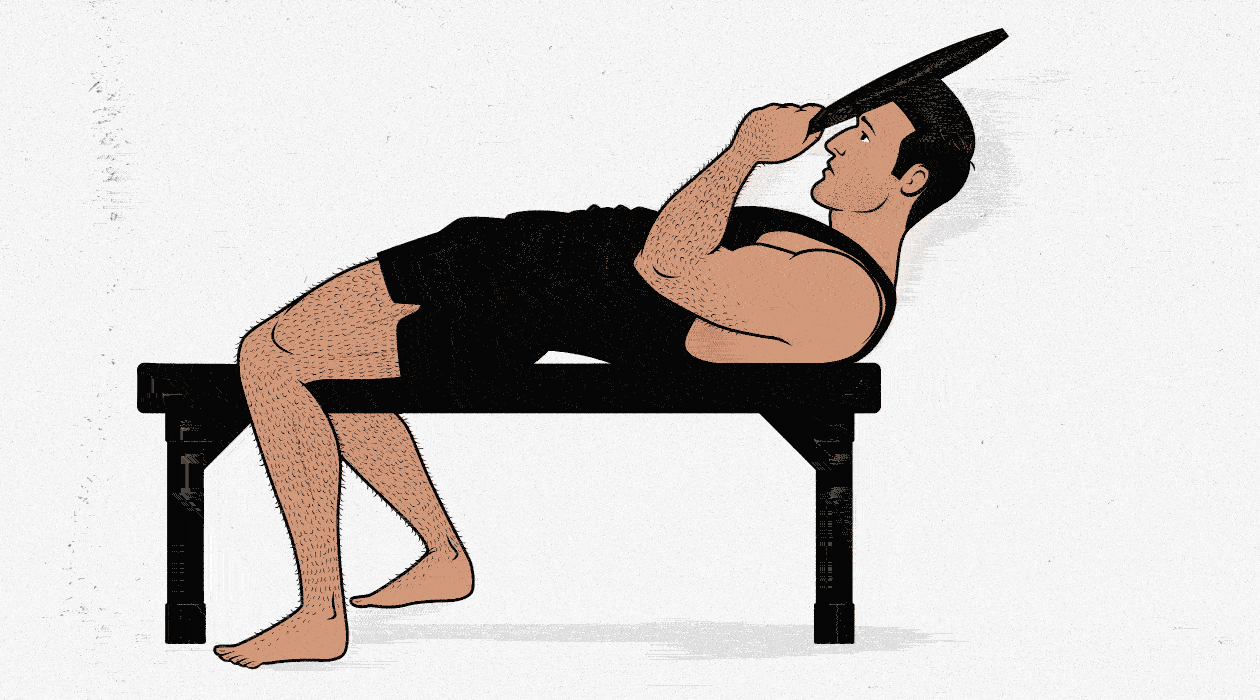
Neck curls are fairly simple to do. You can think of them as doing crunches for your neck. The idea is to stretch out the muscles along the front of your neck and then contract them. However, as we mentioned above, don't worry too much about using a large range of motion. Just worry about feeling your neck muscles curl the weight up (as opposed to pulling the weight up with your hands).
I like to do these with rubber bumper plates, but you can do them with really anything. You can even do them by pushing against your head with your hands. The only advantage that weights offer is that they allow us to add precise amounts of weight every week.
Note: if you're using hard metal plates for these, you'll want to wear a hat, bandana, or put a towel between the plate and your head. Otherwise, you may get a bruise or callus on your forehead.
The Neck Extension
In addition to doing neck curls, we also want to train the spinal erectors and upper traps running along the back of our necks. To do this, we flip around and do neck extensions:
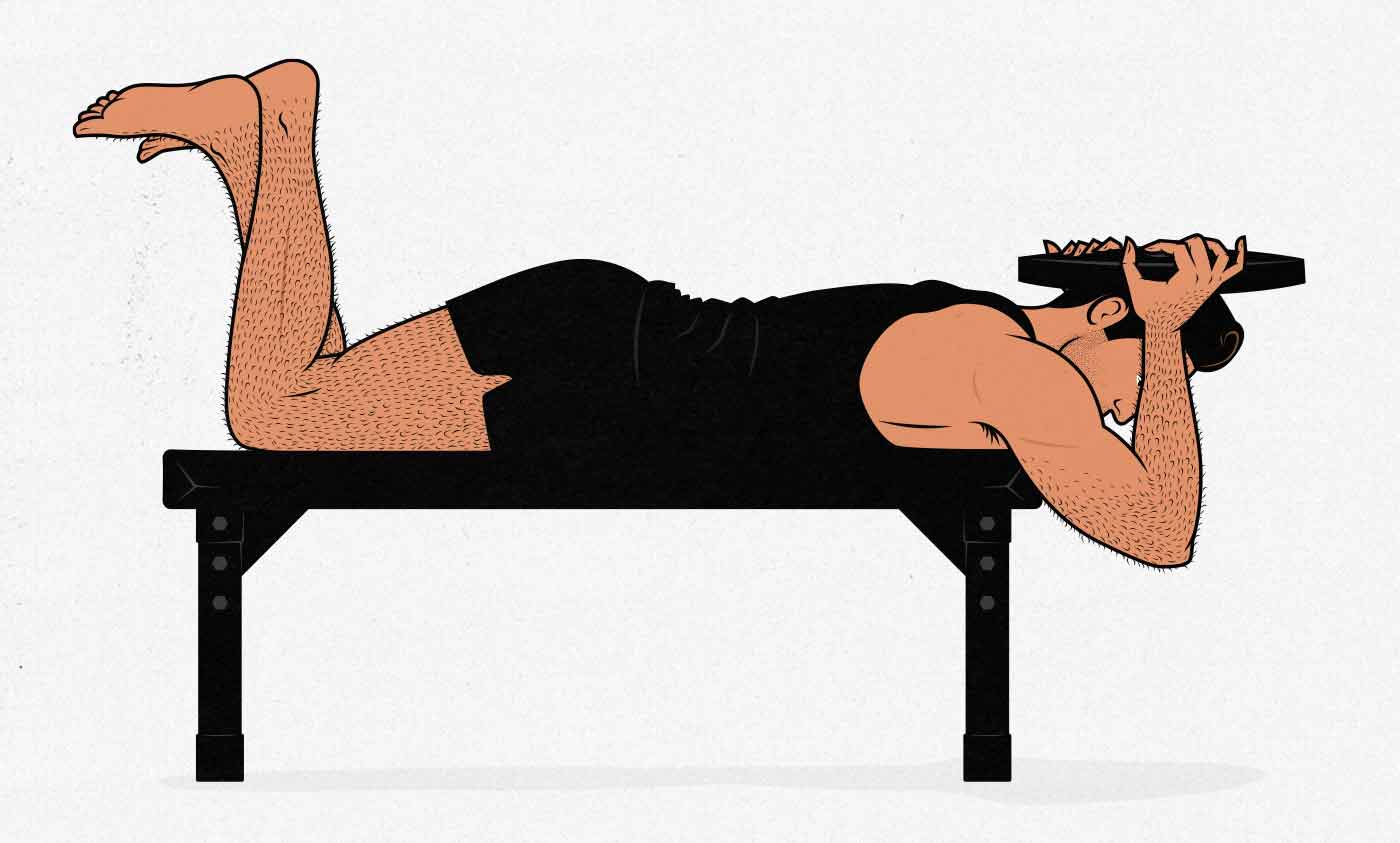
The simplest way to do neck extensions is to put a plate on the back of your head and then extend it backwards—the same technique as with neck curls, just in reverse. However, if you want to take your neck training more seriously, you can get a neck harness.
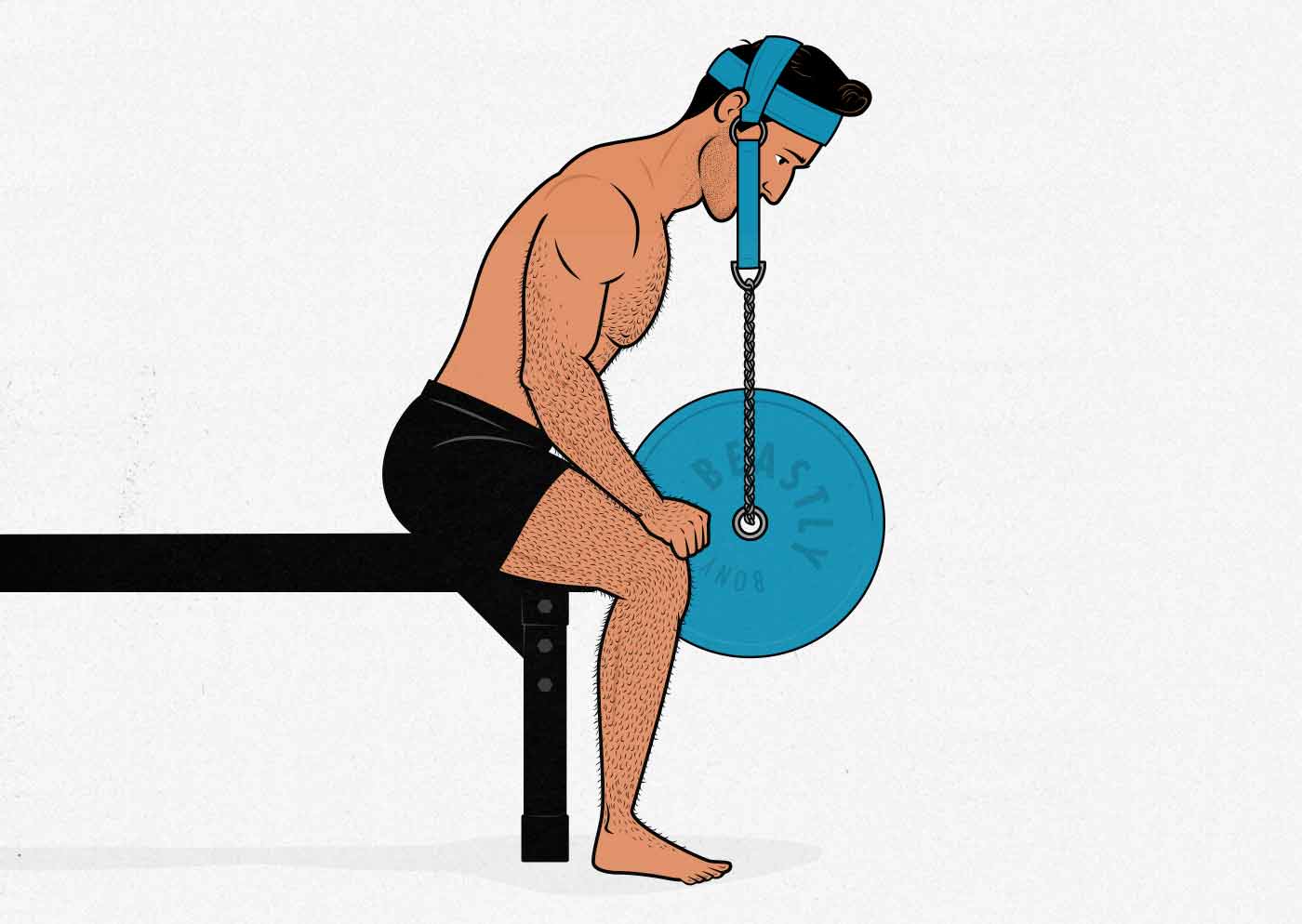
The advantage of the neck harness is that we can plant our hands on our knees for upper-back support. That allows us to better focus on giving our necks a good, heavy workout. It's a satisfying, strenuous movement, and you may be surprised by how much weight you can lift.
To be clear, though, you don't need a neck harness, and if all you're trying to do is build a pleasantly muscular neck, you probably don't need one. I bought a couple of them to test them out, and they do make heavy neck extensions quite a bit easier. I recommend getting one. But to make sure that my results were reproducible, I bulked up my neck using just weight plates.
Neck Side Raises
Finally, we have side raises. To do these, you can lie somewhat awkwardly on the bench and flex your neck sideways. Again, any resistance will work (including your hands). I used weight plates so that I could gradually use heavier loads over time, making it easier to gauge my progress.
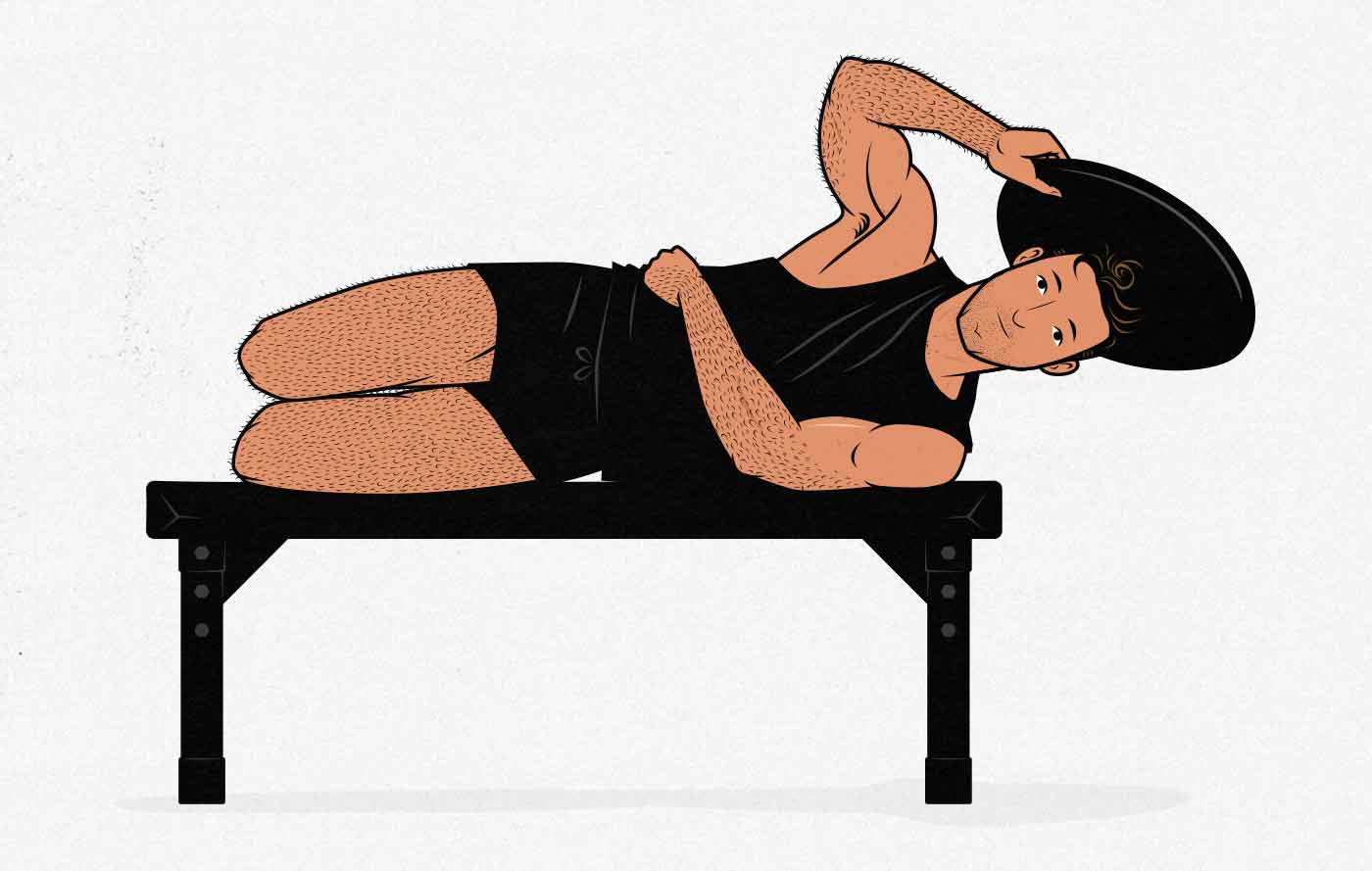
Neck side raises aren't strictly necessary, but they're a nice way to increase our neck training volume without needing to grind through the same lifts over and over again. They may also help us build our neck muscles more symmetrically.
Ease In But Dig Deep
Neck training is a funny thing. If you're like me, you might be under the impression that your neck is weak and fragile. Strenuous weighted neck training might seem daunting, even reckless. And to be fair, if your neck is still skinny, then it is weak. After watching guys on YouTube curl 45-pound plates, I was ashamed to learn that I could only curl ten pounds. And if you've never trained your neck before, then it is fragile. I was shocked by how sore my neck got during my first week of training. But within a few weeks, you'll realize that your neck is tough and that neck training actually feels quite safe.
However, that doesn't mean that you should dive all the way into hearty neck training in your very first workout. The first time the muscles in your throat get sore, it feels fairly similar to having a sore throat, and you may fear that you've gotten sick. The harder you train in those first workouts, the more crippling that soreness will be. Better to ease into it. I recommend starting with just two sets per neck exercise and stopping a good 2–3 reps shy of failure. That will keep the soreness is manageable.
As your neck grows thicker, stronger, and tougher, you can gradually add sets and start training closer to failure. A few weeks from now, doing five sets of neck curls per workout isn't out of the question. And expect to increase the load steadily. If you start with a ten-pound plate in your first week, expect to gradually work your way up to 25+ pounds in a month or two. Your neck is tough, and the muscles will grow strong. You'll be surprised by what you're able to accomplish in a relatively short period of time.
What surprised me most of all was that neck training started to feel really good once I got used to it. Doing heavy neck extensions with a neck harness sends a pleasant rush of blood to my head, and the soreness that settled in afterwards feels like getting a day-long neck massage.
As I've gotten more experienced with neck training, my neck has started to feel noticeably sturdier and tougher. The training has become hearty and strenuous. I've come to really enjoy it. It wasn't what I expected.
Warm-Ups and Neck Stiffness
When we cause a lot of muscle damage, it can make our muscles feel quite stiff. When that stiffness is in our necks, it can be quite annoying and sometimes a little scary. The main way to avoid that is to ease into your neck training. Don't go all-out in your very first workout. Start easy and gradually work your way up.
However, even then, you might notice that your neck feels a little bit stiff at first. One way to avoid that is to do some bodyweight neck stretches—twists, circles, and so on—before and after your neck training, as well as on rest days. You can also do bodyweight neck curls and extensions as warm-up sets before loading them up heavier.
Sets, Reps & Training Frequency
You can train your neck 2–3 times per week with 2–5 sets per workout. Most research shows that we can maximize growth by training our muscles twice per week. I recommend easing into your neck training slowly. These muscles have likely never been trained before, so even a small amount of training will be enough to provoke growth and make your neck muscles quite sore (which can feel like having a sore throat). Start with two sets per exercise per workout and gradually work your way up.
At the peak of my neck training, I did three sets of curls, extensions, and side raises three times per week, which took around ten minutes per workout. That's nine sets per movement per week, but with both the neck curls and side raises working the sternocleidomastoid, that's a training volume of eighteen sets per week on the muscles that contribute most to our neck size and aesthetics.
Aim for 15–25 reps per set and leave a couple of reps in reserve.Most research shows that we build muscle the most efficiently when we do 6–20 reps per set. But since these are smaller isolation lifts that we're doing, it's a bit of an exception, and it can pay to do even more reps than that. I recommend doing 15–25 reps, getting a good mind-muscle connection, and aiming for a fierce muscle pump.
Short rest periods are fine. Because our neck muscles are relatively small, we often get away with doing higher-rep sets with shorter rest times without our cardiovascular fitness ever limiting us. A quick couple of runs through a circuit of neck curls, extensions, and side raises works great. However, short rest times aren't required, either. You could just as easily do your neck training while resting between sets of compound lifts.
Track your weight/reps/sets and always try to be improving. Like all of our other lifts, to gain muscle size, we need to focus on getting stronger at our lifts. We need to be adding weight, adding reps, reducing rest times, or adding sets. Our neck muscles have good potential for growth and can grow surprisingly strong. You might surprise yourself with how quickly you can improve.
Adding weight with limited equipment.When trying to add weight to our lifts, it's often best to add 2.5–5 pounds whenever we get to the top of our target rep range (25 repetitions in this case). However, depending on what equipment you're using, that might be hard. If you're holding a weight plate on your head, you might only be able to go up in increments of five or even ten pounds. In that case, be a bit more flexible with your rep ranges. Sets of up to 40 reps are just as good for stimulating muscle growth (they're just longer and more painful).
Avoiding forehead bruises.Most people do their neck curls by holding rough steel plates against their foreheads. To prevent the plates from bruising or callusing their faces, they wear a toque or pad the plate with a towel. (I've been using rubber bumper plates, and I bravely neglected to use any padding.)
Avoiding "zingers."I haven't run into this problem yet because I've been lifting pretty cautiously, but it's fairly common for people to strain their neck muscles by jerking the weight around. To avoid this, lift steadily and maintain control of the weight, and if you're using a neck harness, avoid bouncing the plates on the ground.
Build muscle overall.Given that your neck is likely completely untrained, it's probably possible to make progress even if you aren't gaining weight on the scale each week. Still, if you want to speed up your progress, make sure you're eating enough calories and protein to gain weight. As always, we need to fuel our muscle growth with the food we eat.
Tracking Progress (& Neck Measurements)
As with building muscle in general, the most important thing is to track our results and adjust accordingly. That's the only way to know if what we're doing is working. And if what we're doing isn't working, then no amount of patience or persistence will yield results. Results only come from the accumulation of gradual progress.
Since our goal is to build a thicker neck, the first thing to do is measure your neck. That will give us our starting measurement.
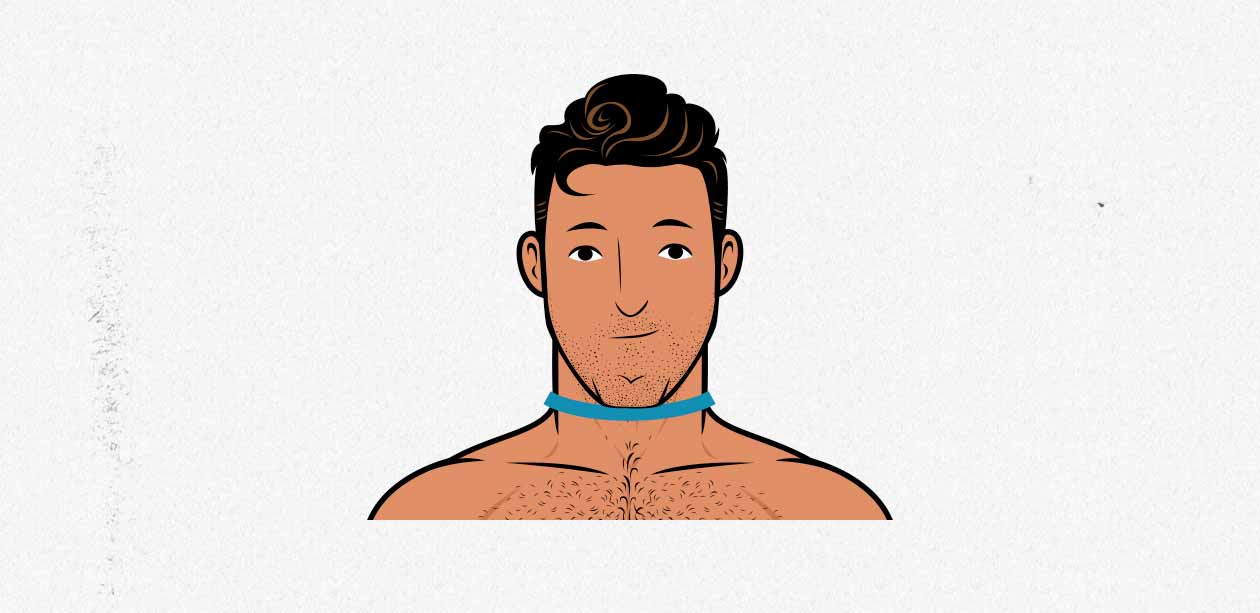
To measure your neck circumference, wrap a measuring tape around the base of your neck, right above your traps (as shown above). This lines up with the neck measurement you'd use to measure your collar size, but more importantly, it's a great place to measure the growth of our sternocleidomastoid and spinal erector muscles.
The other thing to keep track of is your neck strength and work capacity. To track your neck strength, keep track of how many reps you can get with a given weight. To track your neck's work capacity, keep track of how many sets you're doing per workout (and per week). Write all of this down.
Every workout, try to either add reps, add weight, or add sets. Keep track of your progress week by week. If you're improving, great. If you aren't making progress, consider adding extra sets. Also, consider taking a set all the way to failure to make sure that you aren't accidentally leaving too many reps in reserve.
Finally, make sure that you're gaining at least a little bit of weight on the scale each week. Yes, if your neck is completely untrained, you can probably make progress without gaining weight. You may even be able to make progress while losing weight. Even so, the single most important factor when trying to build muscle is that you're eating enough calories to add overall mass to your frame. If you ever hit a muscle growth plateau, look first to the scale. Have you been gaining weight?
Frequently Asked Questions
What Exercises Work Your Neck?
Which exercises train your neck muscles? If you're asking about compound lifts, none of them. None of the big compound lifts will stimulate the muscles in your neck. That's why until people start training their necks directly, their necks don't grow.
The only exception is that some lifts—such as deadlifts, shrugs, overhead presses, and lateral raises—train the traps, which are at the base of your neck. Building bigger traps will absolutely make your upper body look more muscular, but it won't make your neck any thicker.
The best exercises for the neck are isolation exercises:
- Neck curls
- Neck extensions
- Neck bridges
- Neck planks
- Neck side raises
Of these exercises, neck curls and neck extensions tend to be the best, and when combined, they make for a fairly complete, minimalist neck training routine.
Why Don't Bodybuilders Build Bigger Necks?
If you look at natural bodybuilders, you'll notice that many of them have fairly skinny necks. I was curious about this. I mean, bodybuilders care a great deal about aesthetics, and building a more muscular neck is one of the best things you can do for aesthetics.
I asked Eric Helms, PhD, why bodybuilders don't train their necks. Helms is a muscle hypertrophy researcher as well as being a competitive natural bodybuilder. If anyone would know, he would. He explained that the biggest professional bodybuilders develop thick necks simply from the gear they use. Their entire bodies bulk up, including their faces, their necks—everything. If they add neck training on top of that, they risk building such a thick neck that it restricts airflow (as we've discussed above).
However, this obviously isn't a problem with natural bodybuilders. After all, they aren't using any gear, so their necks won't grow unless they deliberately bulk them up. And even if they intentionally train their necks, it's unlikely that their necks would grow so thick that it causes a problem.
Dr Helms then explained that neck muscularity isn't a judging factor in bodybuilding. The rules of bodybuilding flow down from the professional bodybuilders, so if they aren't bulking their necks, then the natural guys won't do it either. Neck training just isn't part of bodybuilding culture.
Finally, it seems like many bodybuilders are naturally muscular, with naturally thicker necks. They don't need to build thicker necks because they were born with thicker necks. Their necks shrink during the final stages of contest preparation because of how lean they're getting, but in their everyday lives, their necks are often quite proportionate.
Why Don't Powerlifters Train Their Necks?
When it comes to powerlifting and strength training, people are judged based on their strength at the barbell squat, deadlift, and bench press. Strength training is also unique in that the idea of specificity is emphasized. Training is focused on becoming stronger at just those three lifts. Neck strength isn't a factor, and so it's ignored.
Do Deadlifts Build Thicker Necks?
No; deadlifts don't engage our neck muscles. The neck muscles that contribute most to our neck muscularity are in front of our necks, such as the sternocleidomastoid. These muscles aren't properly trained with any compound lift, including the deadlift.
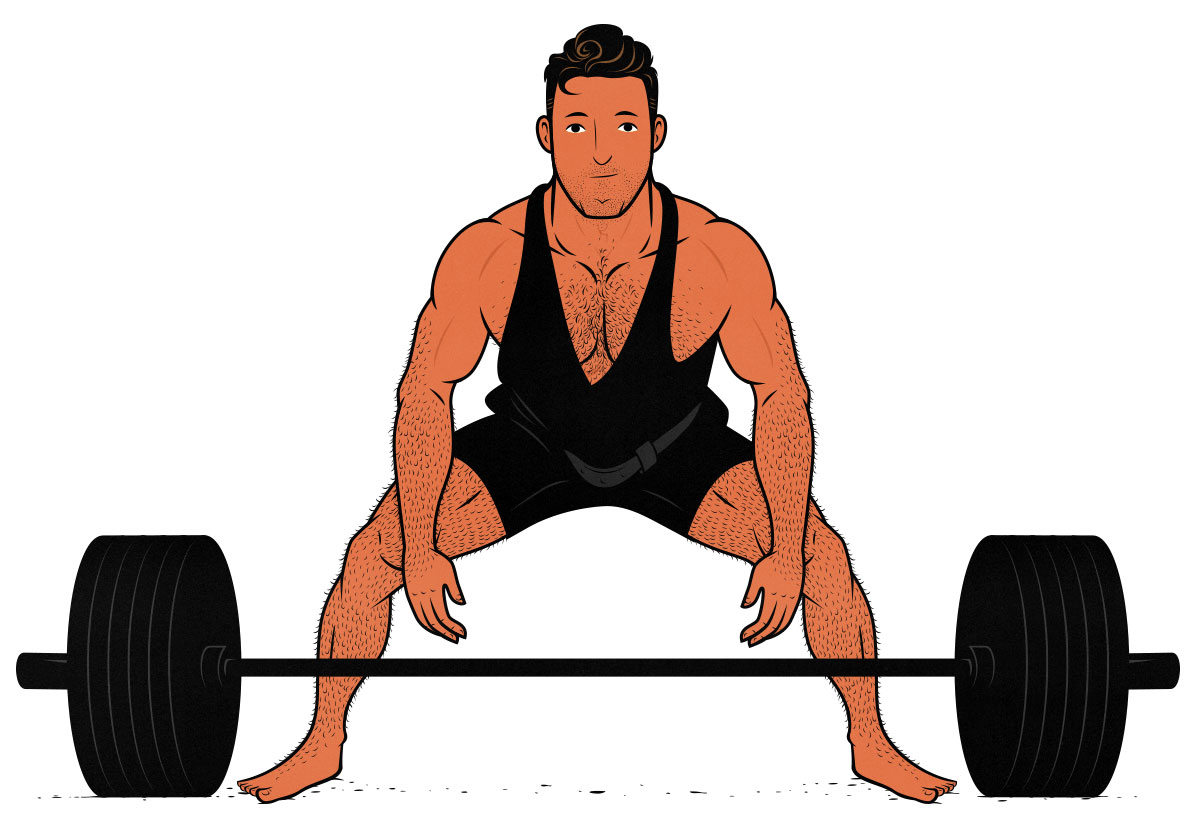
The long answer is that deadlifts do train your traps, which are technically part of our necks. Furthermore, there are a few examples of people who bulked up their necks simply by deadlifting. Most people consider the traps an upper-back muscle. After all, at least when lifting weights, we use them mainly for deadlifting and rowing movements. However, the upper traps are also involved with neck extension, so they're technically a neck muscle.
Your traps will absolutely get bigger simply from doing the big compound lifts:
- The classic barbell deadlift will bulk up your traps no problem. By the time you can deadlift 405 pounds, you'll necessarily have big traps.
- The overhead press and push press will also bulk up your traps. When you press a weight overhead, your traps assist your shoulder muscles. Both bulk up together. A good goal to work towards for a bigger shoulder girdle is to do a few reps in a row with 135 pounds.
- Even lateral shoulder raises are great for your traps. These are primarily used for building broader shoulders, but they're also great for bulking up your traps. Just like with overhead pressing, the traps and shoulders work together to raise the weight.
Yes, we could use also use shrugs to bulk up our traps. Still, because of how thoroughly several different compound lifts stimulate them, there isn't actually much benefit to isolating them. (This is different from muscles like our biceps, which aren't fully engaged by compound lifts, such as the chin-up. That's why adding in biceps curls helps with biceps growth.)
To make matters more confusing, some lifters do build visibly bigger necks simply from compound lifts. A good example of this is Omar Isuf, who built his neck dangerously large without training it. He thinks this is due to deadlifting with quite a bit of neck strain. (Also, keep in mind that he can deadlift over 600 pounds.)
However, other lifters get just as strong as Omar Isuf without any increase in neck size whatsoever. A good example of this is Jeff Nippard. His neck was so small that he's one of the only natural bodybuilders who started intentionally training it. He's got a 500-pound deadlift, so he's certainly a damn strong dude.
As you can tell, I was more like Jeff Nippard. And in my experience helping thousands of skinny guys bulk up, this tends to be incredibly common for us so-called "ectomorphs." In fact, after helping nearly 10,000 skinny guys bulk up, I haven't seen a single person build a massive neck just from deadlifting. This leads me to believe that if you have a naturally thin neck, it will probably stay thin until you start training it directly.
Will Our Necks Shrink if We Stop Training Them?
The interesting thing about building a thicker neck is that it seems like a lot of former football players, boxers, and martial artists maintain muscular necks decades after they stop training them. A popular example is the actor Channing Tatum, who built a bigger neck while doing martial arts and playing football in college. Afterwards, he completely stopped training his neck, yet even twenty years later, people still commented on how muscular it was.
That's a bit confusing because if our necks respond similarly to our other muscles, we'd expect to lose at least a little bit of muscle size when we stop training them. Not all—some of the changes in our muscles are permanent— but it's likely that if we completely stop training our necks, they'd get at least a little bit smaller. Maybe never as small as they used to be, but not at peak size either.
However, this all depends on whether our necks get any stimulation from our other training. It could be that the small amount of neck strain we get from, say, deadlifting that we're able to maintain our size with no additional neck isolation exercises.
After gaining nearly two inches on my neck, I stopped training it for a few months and recorded the changes. Within the first week, I lost a tiny bit of size as my neck fully recovered from the training and the inflammation/extra glycogen in the muscles faded. I gradually lost a small amount of size during the next two months, but not as much as I'd expected. Of the two inches I'd gained, I kept about 1.25–1.5″ after six months of not training my neck.
After that, I experimented with bringing a small amount of neck training back into my workouts to see what a minimalistic long-term neck training routine might look like. It seems like I can maintain my neck size with 2–3 sets of neck curls per week, which can be done during a warm-up routine or while resting between sets.
So, if you get your neck strong enough, you won't ever need to worry about having a skinny neck again, especially if your neck is being stimulated during compound lifts (such as deadlifts). On the other hand, if you want to maintain your neck at peak muscularity, you'll need to keep at least a bit of neck curling in your workout routine.
How Can You Train Your Neck at Home?
You don't need weights to train your neck. There are plenty of bodyweight neck exercises. The most famous is the neck bridge, which is how many wrestlers, fighters, and football players build thicker necks.
Are Neck Workouts Bad for You?
No, there's no reason to think that neck workouts are dangerous or bad for you. They do train the spine, and it's always wise to be careful when training your spine. Still, neck exercises tend to be relatively light, especially compared to other exercises that load the spine, such as the deadlift. Because of the lighter loads you're using, there's less shear stress on your spine, and so the risk of injury is quite a bit lower.
Plus, neck training has several benefits, including increased resilience to concussions and traumatic brain injuries, such as those you might get in a fight or car crash. That's why neck training is so ubiquitous in combat sports like boxing, MMA, and football.
Do Shrugs Train the Neck?
Will shrugs help us build a thicker neck? Yes and no. Shrugs train the traps (upper trapezius muscles), and our traps do connect to our necks. But when most of us think of our neck muscles, we're thinking of our neck flexors and extensors, not our traps. To build thicker necks, we need to train our necks directly.
Summary
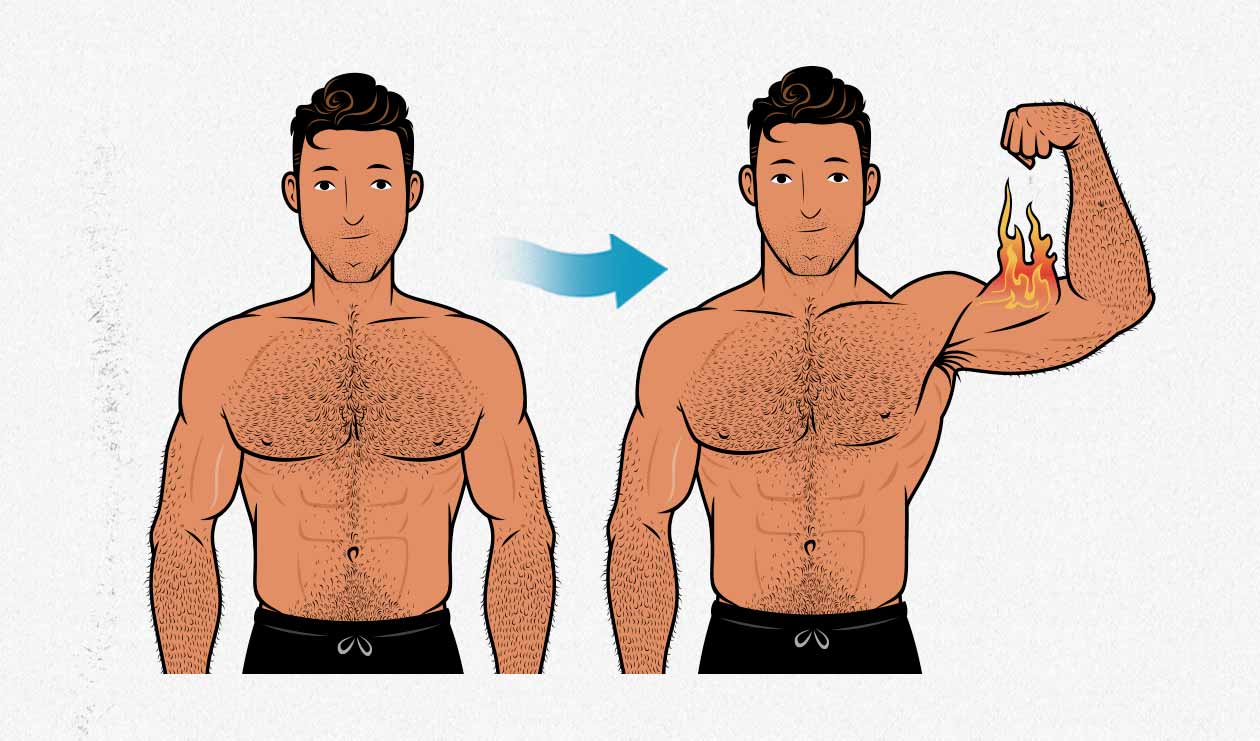
The big compound lifts don't stimulate our neck muscles, and so unless we train them directly, they will stay small, no matter how much muscle we build overall. Fortunately, neck training is a safe and effective way to build a thicker neck.
There are three main movements that will help us build bigger neck muscles:
- The Neck Curl trains the sternocleidomastoid (and other neck muscles), making our neck thicker when viewed from the front.
- The Neck Extension trains our spinal erectors, making our necks thicker when viewed from the back.
- The Neck Side Raise, which also trains the sternocleidomastoid (and other neck muscles), makes our neck thicker when viewed from the side.
Although our upper traps are more of an upper-back muscle than a neck muscle, they can certainly make our necks look more muscular. Fortunately, our traps get plenty of stimulation from compound lifts like the deadlift, which loads them heavy in a stretched position, and the overhead press, which works them through a large range of motion. Lateral raises and shrugs also help to bulk up the upper traps.
We can train our necks 2–3 times per week with 2–5 sets per movement, giving us a weekly training volume of somewhere between 6–18 sets per muscle group. Sets of 15–25 reps tend to work best, but doing up to forty reps per set is effective.

It's not uncommon for people to gain an inch or two in neck circumference within just their first few months of training. Not only will that make your neck stronger and improve your aesthetics, but it will also allow you make other improvements to your appearance, such as being able to wear heavier hats.

If you want more muscle-building information, we have a free bulking newsletter for skinny guys. If you want a full bulking program, including a 5-month workout routine, diet guide, recipe book, and online coaching, check out our Bony to Beastly Bulking Program. Or, if you want an intermediate bulking routine, check out our Outlift Intermediate Bulking Program.
washingtonbrin1950.blogspot.com
Source: https://bonytobeastly.com/how-to-build-a-thicker-neck/

0 Response to "Muscle Building Exercises Easy on the Neck"
Post a Comment